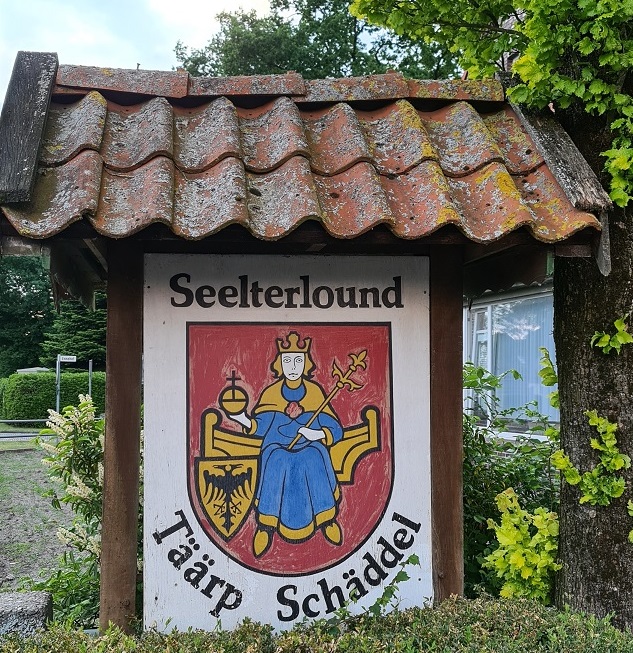Abstract
This paper investigates the linguistic landscape of Saterland, a municipality in northwestern Germany with a population of 14,313, spread out across four villages. Saterland is home to the Sater-Frisian language, which is considered to be the smallest national minority language in Europe. The study aims to document the presence and relative frequency of the German and Sater-Frisian languages in public signage. Data collection was done by photographing 400 public signs and boards along the main road and its immediate side streets on 23 and 24 May 2024. The results indicate that Sater-Frisian is predominantly visible on place-name signs and tourist-oriented boards managed by the municipality, reflecting its role in cultural heritage rather than active communication. In contrast, German dominates public and commercial signage. Sater-Frisian is also absent in the digital environment due to the lack of a digital language model for automatic translation. Despite these challenges, efforts to increase the visibility of Sater-Frisian are undertaken by the local government. Initiatives include bilingual signs in public buildings and future plans for Sater-Frisian street names in a developing industrial area. The study’s scope was limited to the public signage along the main central road. Variations in the visibility of the two languages may exist in other parts of the municipality.
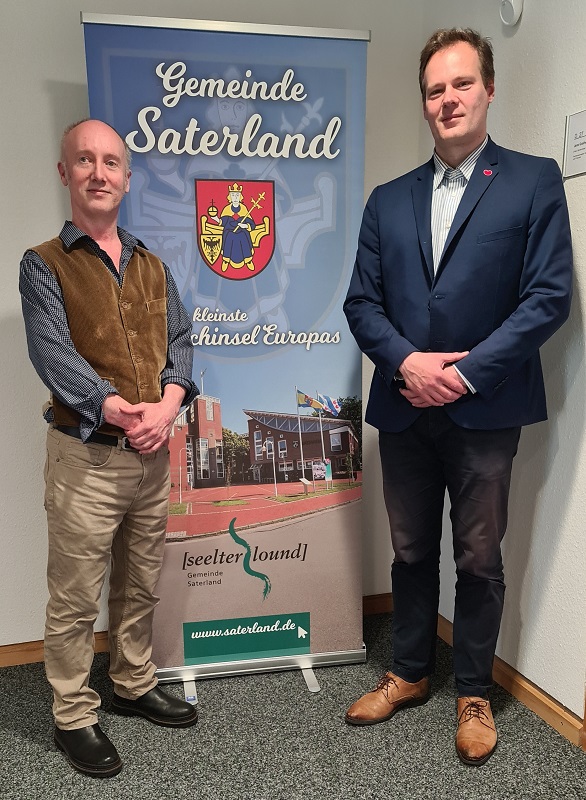
Introduction
Saterland (Seelterlound) is a municipality with an area of 123.6 km2 and a population of 14.313[1] that consists of four villages in northwestern Germany. These villages are inhabited by a community which speaks a minority language that is considered to be the smallest national minority language in Europe, with a few thousand active speakers. Most of the population in Saterland consists of people whose ancestry lies to the north along the northern German coast, which in historical times was (East-)Frisian speaking. Currently, they are the only speakers of this language, which is called Sater-Frisian (or Seeltersk in the native tongue).
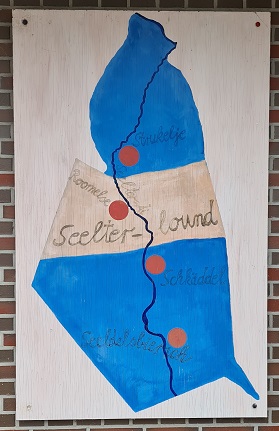
The investigation into the linguistic landscape of Saterland focused on documenting the signs that are visible from the main roads of the municipality, with the aim of determining the relative frequency of the German versus Sater-Frisian language in the public domain. In preparation for this observation, an overview of the streets of the four villages that make up the municipality was done. Subsequently, the choice was made to focus on the main road that connects the four villages, as well as the direct side streets of this road, because most of the main public and commercial activities take place in that area.
The data of this study was collected on 23 and 24 May 2024 by visiting all four villages and documenting the public signs and boards by taking 400 photographs.
Sater-Frisian street names
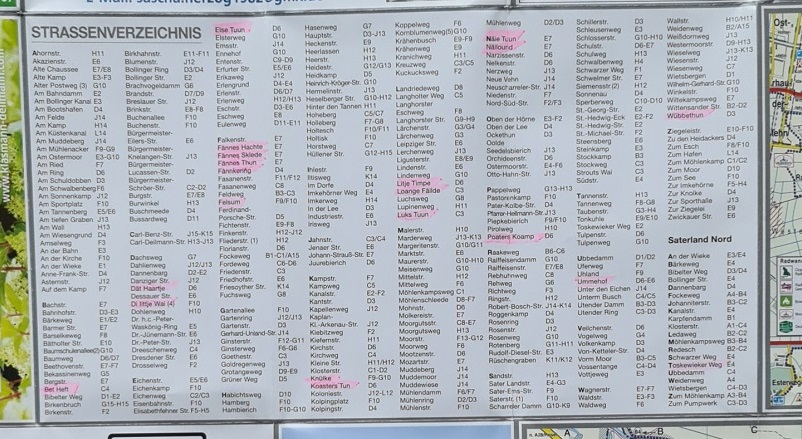
According to the official map published by the municipality of Saterland, there are 367 different street names. Of those 367 streets, 20 (twenty) have a Sater-Frisian name. This amounts to 5.4 percent of the total number of streets.
The streets with a Sater-Frisian name are distributed among the various villages of the municipality. It provides an indication to where Sater-Frisian is more prevalent. For example, the most southern village of Sedelsberg, has no Sater-Frisian street names, while Ramsloh currently has the greatest number. Furthermore, the number of Sater-Frisian street names will increase markedly in the next few years, because a new industrial area in the north of Strücklingen/Strukelje is being developed. The streets in that area will receive Sater-Frisian names.[1]
| Village name | Population | Number of Sater-Frisian street names |
| Strücklingen/Strukelje | 3287 | 5 |
| Ramsloh/Roomelse | 5281 | 12 |
| Scharrel/Skäddel | 2624 | 3 |
| Sedelsberg/Seedelsbierich | 3040 | 0 |
Place-name signs

The first public signs that are visible when entering Saterland are those of the various villages, depending on what direction people enter. The study looked at the language used on these official place-name signs. The sample was taken when entering and exiting the villages through the main road. The place-name sign at the entrance of every village in Saterland has both the German and Sater-Frisian name on the sign. The German name is always on top and in bigger letters, with the Sater-Frisian name below it.
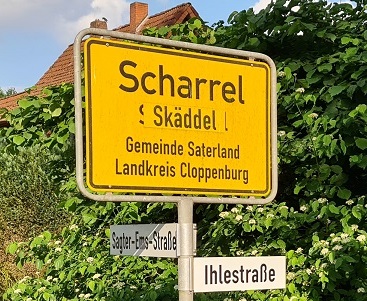
Several place-name signs in Scharrel had a sticker with the new Sater-Frisian name on top of the old one. This is due to the fact that the municipality recently chose a new spelling for Sater-Frisian whereby the ‘sch’ was replaced by ‘sk’ in order to better reflect its pronunciation.[1] The Sater-Frisian language does not have the scraping ‘sch’ sound, which is common in Dutch and German. Instead, the pronunciation is similar to that found in the English language.
Traffic signs
There are many traffic signs in Saterland. The study found three types of standardized traffic signs: distance signs, destination signs and cycling distance signs. All the standardized public traffic signs are managed and created by the regional government[2].
Distance signs
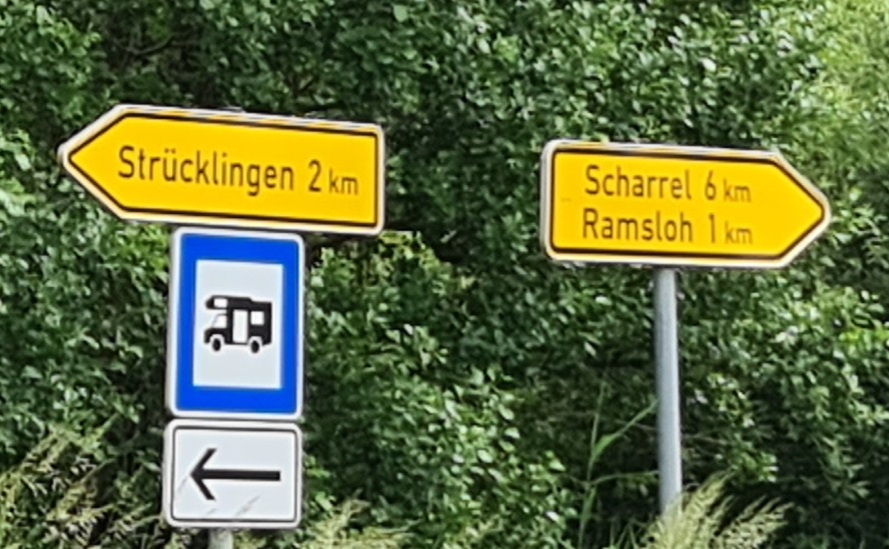
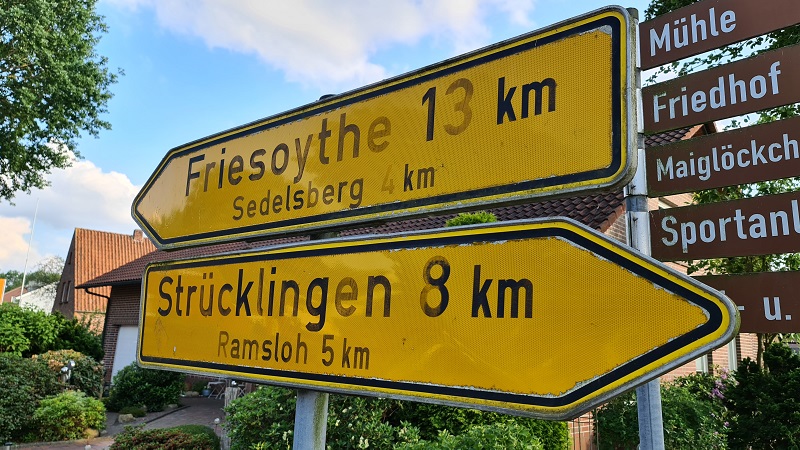
The distance signs, show how many kilometers the next villages and cities are away. Distance signs are also located outside of Saterland, where they always portray the German name with no mention of the Sater-Frisian designation. This is also the case within the Saterland municipality. All the distance signs, one-hundred percent, within the municipality display only the German name of the other villages.
Destination signs
The most numerous public signs in the municipality are those which point to a specific destination, like a school, church or sport accommodation. All these destination signs, one hundred percent, within the municipality display only text in German.
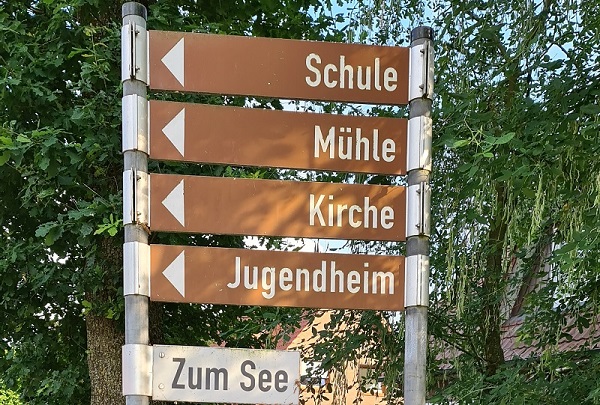
Cycling distance signs
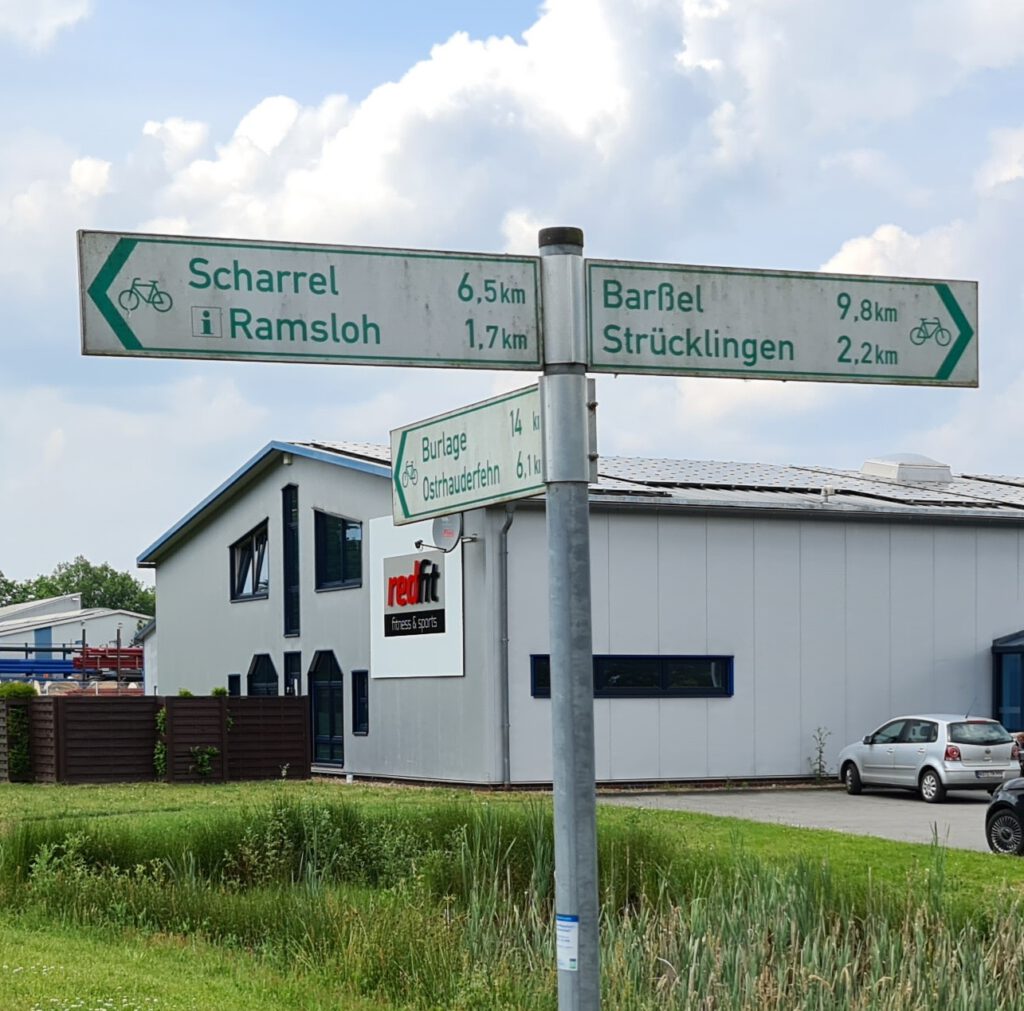
The third standardized traffic signs are the cycling distance signs. These green-and-white signs are abundant in Saterland, reflecting the need or desire for more sustainable modes of transport. All these signs display only the German name of the villages.
Traffic explanations signs
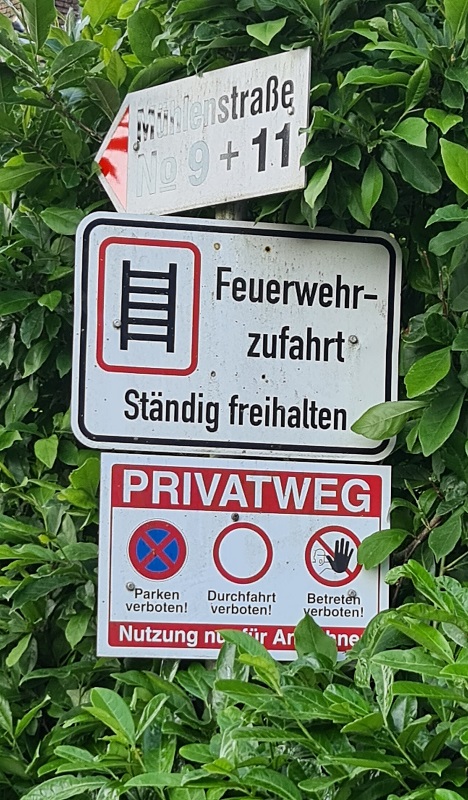
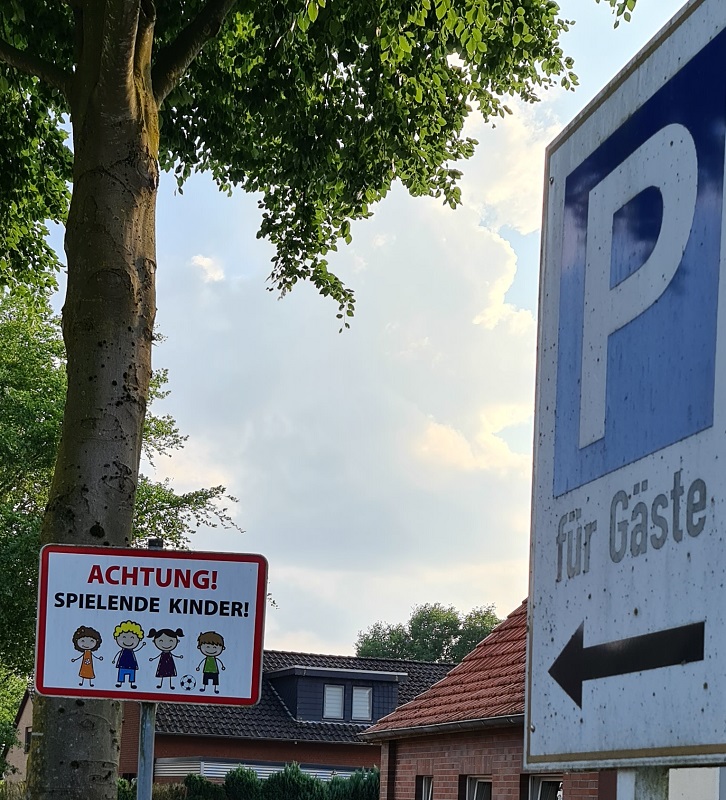
The next category of public signs that the study looked at were the traffic explanation signs. These signs provide the public with information about traffic situations that require additional attention. All the traffic explanation signs, one-hundred percent, within the municipality display only text in German.
Public information
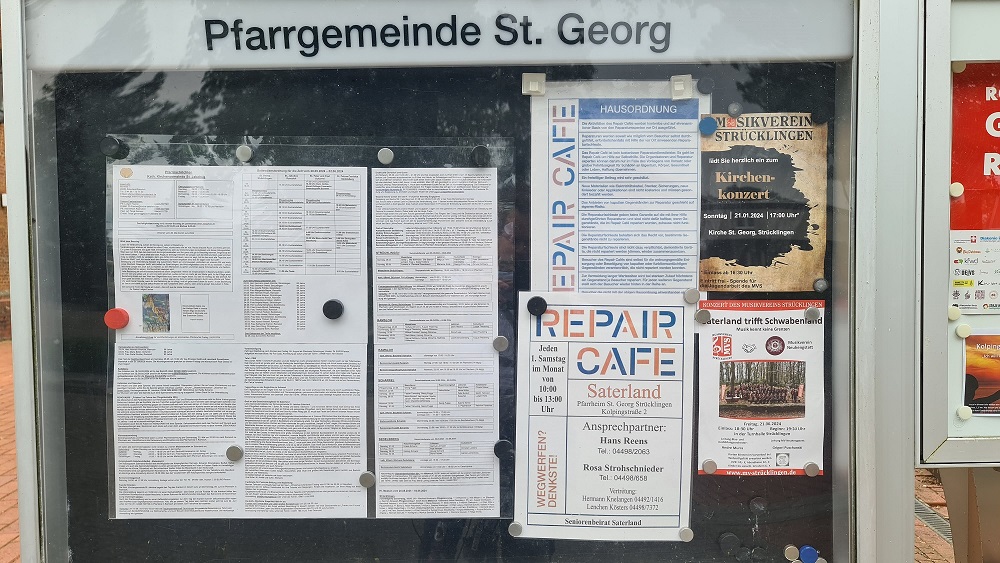
The study also found boards displaying explanatory text and calls for attention for non-commercial activities. Examples of these are information boards by the church, directions for citizens/tourists to important locations within the municipality and notices in parks as well as signs on the partnership with another city. All the boards contained only information in German.
Public objects
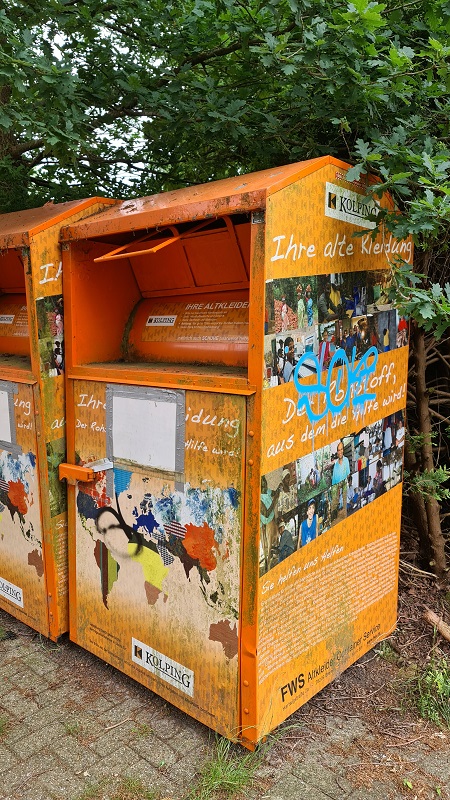
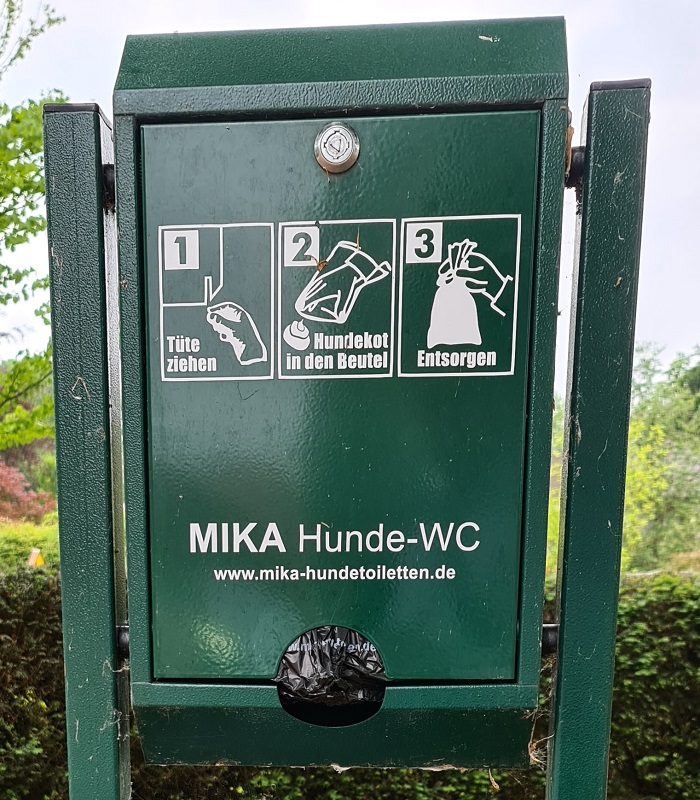
Numerous public objects which stand visible in the street and contain texts describing their use can also be counted towards the linguistic landscape. These public objects consist of various kinds of containers and dog toilets, which have texts describing their use. These texts are one hundred percent in German.
Tourist boards
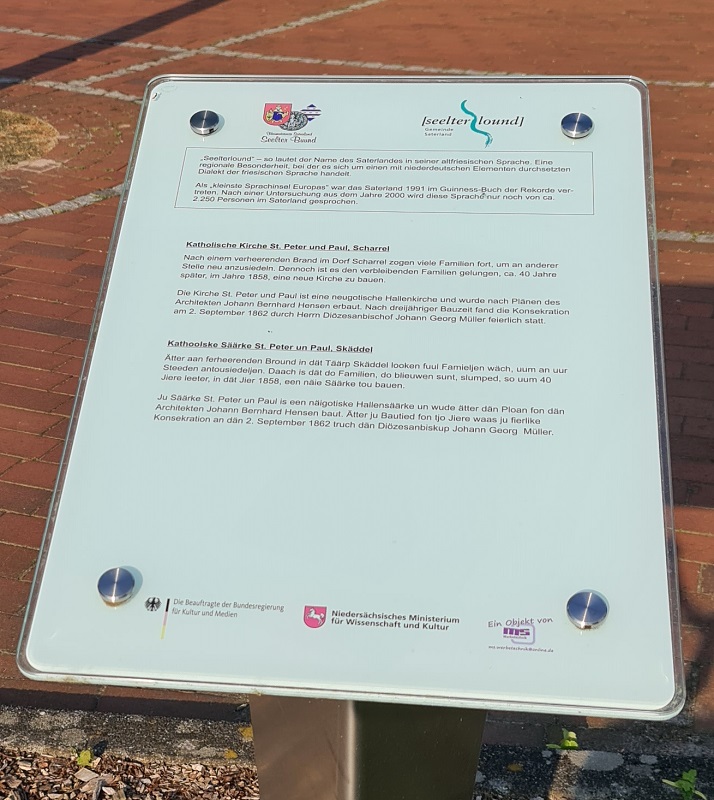
The locations which hold special natural or cultural value within the municipality have public boards that cater to citizens and tourists. These boards explain the history of a church, school, windmill or other public building with a long history. These boards have been placed by the municipality in cooperation with the Seelter Buund, an organization that promotes the Sater-Frisian language. These boards are bilingual. The German text is on top with the Sater-Frisian text below.
The Sater-Frisian language is only spoken within Saterland, which means that the Frisian text is not displayed for tourists who might not be able to read German. If it were catered to an international audience, the text would be in another established (inter-)national language, like English. The choice to put the text in the Sater-Frisian language is therefore most likely in order to show visitors the unique linguistic heritage of the region.
Commercial billboards
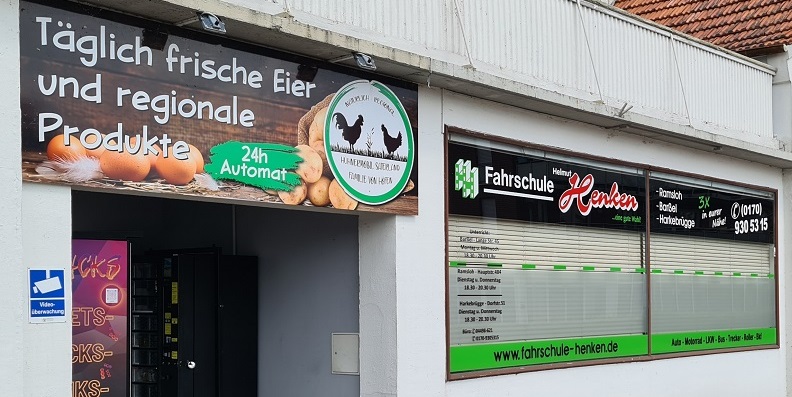
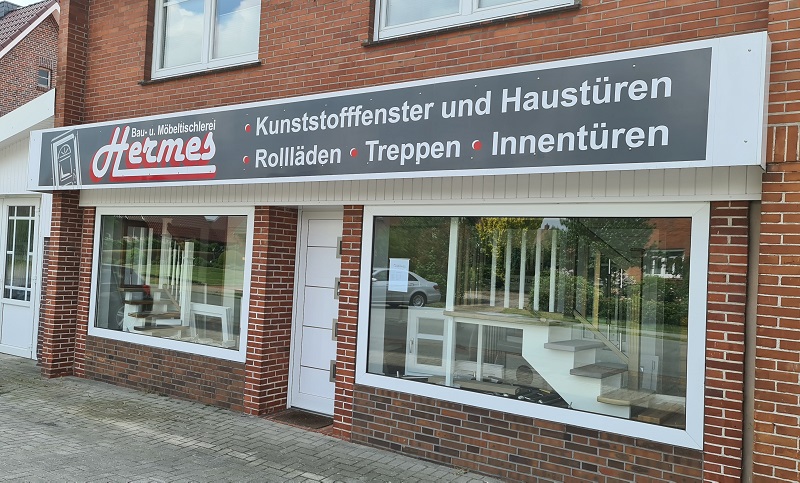
The study also looked into the use of German and Sater-Frisian on signs and billboards from commercial companies within Saterland. These commercial signs are not standardized and each company has a different style, size and way of presentation. In order to get a comprehensive picture of the languages used in these commercial billboards, the study used a sample of one-hundred commercial billboards distributed over the four villages along the main road and direct side streets. Of those one-hundred documented billboards, 98 were in German, while two had Sater-Frisian texts or names. One of these was located in Strücklingen/Strukelje and the other in Ramsloh/Roomelse. Commercial entities do not communicate in Sater-Frisian and also do not refer to the cultural heritage of the area. This indicates that they do not see it as having added value for their business.

Welcome boards
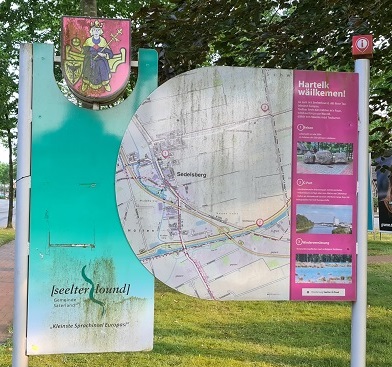
Several boards with descriptions about the villages are located at the entrance and exit of the villages. Every village has a standardized welcome and explanation board, which also serves as a street map of the village. These boards are bilingual, with the eye-catching greetings in Sater-Frisian and the explanations in German.
Furthermore, several non-standardized boards are present in Saterland. The study found an older bilingual entrance/exit sign in Strücklingen/Strukelje and two monolingual Sater-Frisian entrance/exit signs in Scharrel/Skäddel. The new boards were was sponsored by the local bank. According to the scientific official of Saterland, additional boards are planned in other locations in the near future.
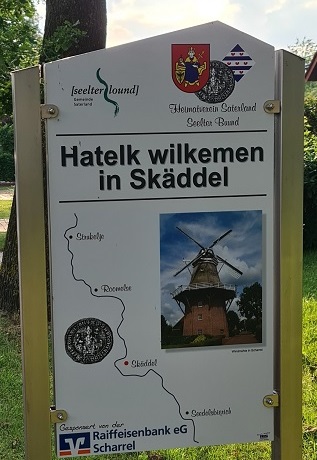
Internal boards

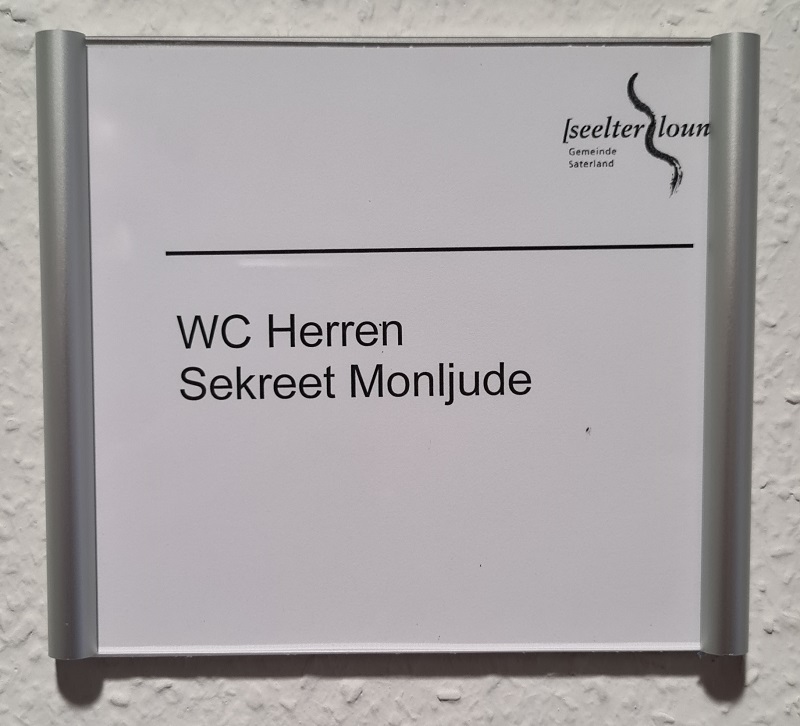
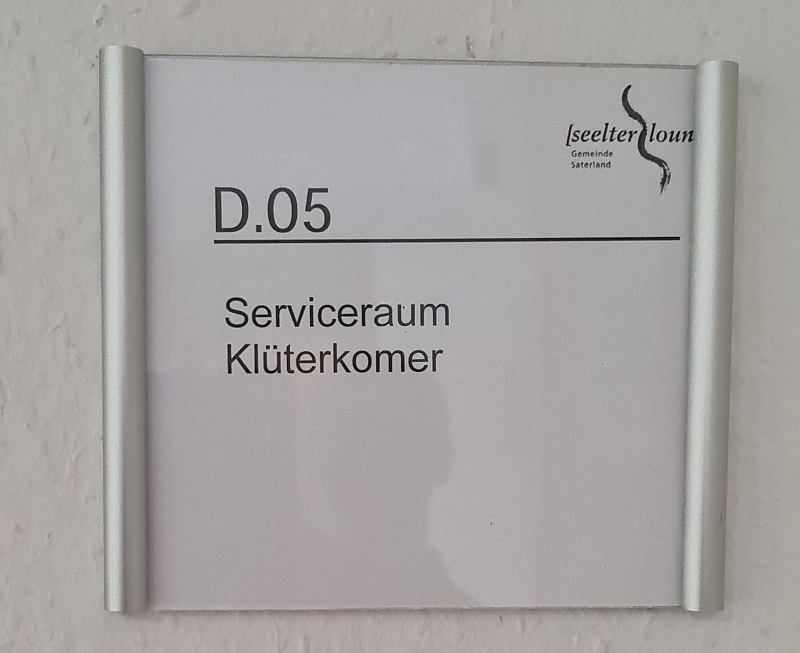
There are also public boards that are not visible on the street. An example are the boards within the municipal building of Saterland in Ramsloh/Roomelse. In 2022, the municipality implemented a project to increase the bilingual character of the local government by creating bilingual plates within the government building. These plates describe the room or area. Many of these plates display newly created Sater-Frisian words. These words were created by a committee in order to express bureaucratic concepts that previously only had German descriptions.
Furthermore, the scientific official for Sater-Frisian explained that there are several plans and ongoing projects to create and place bilingual signs inside super markets and large companies in the near future. There are also numerous other projects to increase the visibility of the Sater-Frisian language on the (public) work floor in the region. One recently finished project concerns a large plastic- and metal producing company, which has new signs and plates in Sater-Frisian on the work floor within the company. There are also discussions with super markets to implement Sater-Frisian on their internal and external boards and signs.[1]
Benches

Numerous benches were documented along the main road, which held a small metal plate with Sater-Frisian text. According to the scientific official for Sater-Frisian, the municipality has 125 city benches, scattered over the four villages. Each bench received a plaque in the winter of 2023-24 with a historic Sater-Frisian saying. These proverbs were collected among the people in Saterland by Dr. Julius Broring in the 19th century. These Sater-Frisian outings are a way to show the cultural heritage of Saterland.

Virtual Linguistic Landscape
The digital public sphere is also important in determining the linguistic landscape. The study looked into the use of German and Sater-Frisian on the websites by the sampled commercial companies in Saterland. Of the sample of one-hundred commercial companies, one-hundred percent had a German-language website.
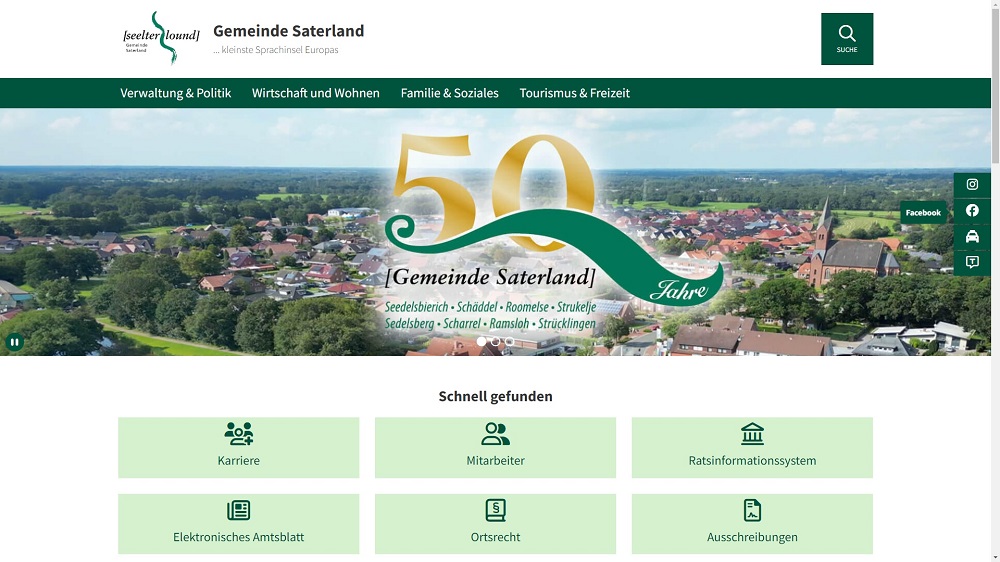
The municipality of Saterland has a website (www.Saterland.de) and an Instagram and Facebook page, which are one-hundred percent in German.
The website of Saterland was bilingual between 26 August 2017 and 21 February 2024[1]. After that period, the website was redesigned and the Sater-Frisian version discontinued. The current website is much more advanced and therefore it is no longer feasible for the local government to have it translated due to the high costs of translation. The content of the previous website was translated by an external translator in Hamburg, Germany.[2] Sater-Frisian is considered a low-resource language and has a limited vocabulary and few literary works. The result of these limitations is that there is no digital language model of the Sater-Frisian language.[3] The amount of data that Artificial Intelligence needs to create a digital language model is too limited in Sater-Frisian. The result is that the Sater-Frisian language is not integrated in standardized office programs and it is not possible to automatically integrate the language into the bureaucratic processes, including the website, of the municipality.

Façades
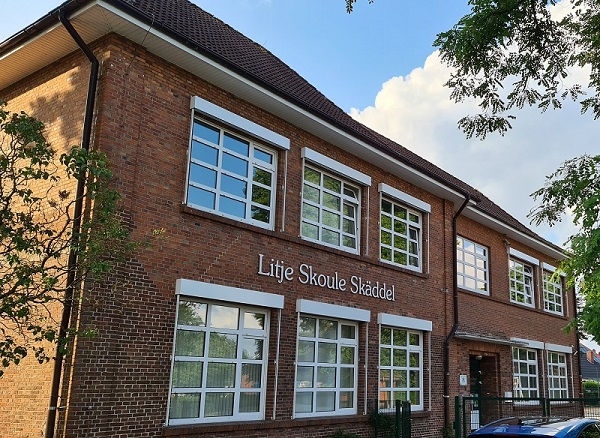
Several buildings in the municipality have a Sater-Frisian name on their façade. The municipal building, the school and the Sater-Frisian cultural house, all in Ramsloh/Roomelse are examples that the study found on, or next to, the main road.
Conclusion
The Sater-Frisian names of the villages in Saterland are only displayed on the place-name signs, but not on any other standardized public road sign. Furthermore, public information in the area is always in German. The same is true for the commercial outings in Saterland. This reflects the dominance of German in public discourse. Sater-Frisian is visible on boards and signs that are aimed at tourists and which are managed by the municipality, in cooperation with community and commercial organizations. Sater-Frisian is also visible on several façades and on plates on the park benches in the area. The visibility of Sater-Frisian therefore mostly offers a perspective on the cultural heritage of the Sater-Frisian people and does not serve as a means of communication. Sater-Frisian is also absent in the digital realm. A major barrier to the cost-effective implementation of Sater-Frisian on digital platforms is the fact that it is a low-resource language without a digital language model; automatic translation is therefore currently not possible. There are numerous efforts to increase the visibility of Sater-Frisian. The local government plays a leading role in this objective. It ordered bilingual plates in the public building of the municipality, whereby a committee created new Sater-Frisian words, and works on plans to make similar internal signs for large companies and supermarkets operating in the area. The local government is also the driving force behind the future increase of Sater-Frisian in street names in the developing industrial area in the north of Saterland. The study was limited to a sample of signs and boards on the main road connecting the four villages. The level of Sater-Frisian in commercial outings and public information might be higher or lower in other parts of the municipality that are less central, which could reflect that in certain neighborhoods the number of Sater-Frisian speakers is higher than in others.
[1] http://web.archive.org/web/20240000000000*/saterfriesisch.saterland.de
[2] Interview with Mr. Henk Wolf, the scientific official of Saterland – 24-5-2024
[3] https://learn.microsoft.com/nl-nl/azure/ai-services/translator/language-support and https://en.wikipedia.org/wiki/Google_Translate
[1] Interview with Mr. Henk Wolf, the scientific official of Saterland – 24-5-2024
[1] http://www.statistik.niedersachsen.de/startseite/
